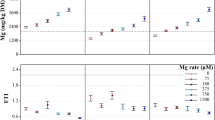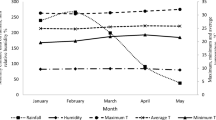Abstract
Aims
An Italian ryegrass cultivar (Lolium multiflorum Lam. cv. Bb2067), selected and bred for increased leaf magnesium (Mg) concentration in the 1970s, reduced the incidence of hypomagnesaemia in sheep under experimental grazings. Here, we report evidence from archival experiments showing that cv. Bb2067 had consistently greater Mg concentrations at multiple sites. We also aimed to quantify variation in leaf Mg concentration among modern perennial ryegrass (Lolium perenne L.), hybrid ryegrass (Lolium perenne × multiflorum), and tall fescue (Festuca arundinacea Shreb.) cultivars.
Methods
Data are reported from unpublished 1980s field-plot experiments for cv. Bb2067 and contemporaneous reference cultivars, sown at two UK locations in 1983 and 1984, and from 397 cultivars of modern forage grass in 13 UK-based breeding experiments sampled in spring 2013.
Results
Across sites, years and cuts, cv. Bb2067 had a consistently greater leaf Mg concentration and lower potassium (K) concentration and forage tetany index (FTI) than reference cultivars in the 1980s experiments. Seasonal variation in leaf Mg and K concentrations and FTI were observed in the 1980s experiments, with K concentrations being generally greatest and Mg concentrations smallest in spring. Among modern forage grasses, there was large variation in leaf Mg concentration (up to 6.3-fold) and FTI (up to 2.1-fold), both within and between species, which varied independently of yield. Among a subset of hybrid ryegrass cultivars, there is evidence that the high Mg trait is already present in some modern breeding lines, albeit previously unreported.
Conclusions
The variation in leaf Mg concentration and FTI among old and new cultivars shows there is considerable potential to breed forages with improved mineral quality to improve livestock health, potentially without compromising yield or other nutritional traits.





Similar content being viewed by others
References
Alcock TA, Havlickova L, He Z, Bancroft I, White PJ, Broadley MR, Graham NS (2017) Identification of candidate genes for calcium and magnesium accumulation in Brassica napus L. by association genetics. Front. Plant Sci 8:1968. https://doi.org/10.3389/fpls.2017.01968
Allsop TF, Pauli JV (1975) Responses to the lowering of magnesium and calcium concentrations in the cerebrospinal fluid of unanaesthetized sheep. Aust J Biol Sci 29:475–481. https://doi.org/10.1071/bi9750475
Asay KH, Mayland HF (1990) Genetic variability for elements associated with grass tetany in Russian wildrye. J Range Manag 43:407–411. https://doi.org/10.2307/3899000
Binnie RC, Johnston DT, Chestnutt DMB (1996) The effect of a high-magnesium perennial ryegrass variety on the magnesium status of sheep. Grass Forage Sci 51:456–463. https://doi.org/10.1111/j.1365-2494.1996.tb02081.x
Broadley MR, Hammond JP, King GJ, Astley D, Bowen HC, Meacham MC, Mead A, Pink DAC, Teakle GR, Hayden RM, Spracklen WP, White PJ (2008) Shoot calcium and magnesium concentrations differ between subtaxa, are highly heritable, and associate with potentially pleiotropic loci in Brassica oleracea. Plant Physiol 146:1707–1720. https://doi.org/10.1104/pp.107.114645
Cranfield University (2019) The soils guide UK: Cranfield University. Available from: www.landis.org.uk
Emmett BA, Reynolds B, Chamberlain PM, Rowe E, Spurgeon D, Brittain SA, Frogbrook Z, Hughes S, Lawlor AJ, Poskitt J, Potter E, Robinson DA, Scott A, Wood C, Woods C (2010) Countryside survey: soils report from 2007. Technical report no. 9/07. NERC/Centre Ecol Hydrol
Graham NS, Hammond JP, Lysenko A, Mayes S, ÓLochlainn S, Blasco B, Bowen HC, Rawlings CJ, Rios JJ, Welham S, PWC C, Dupuy LX, King GJ, White PJ, Broadley MR (2014) Genetical and comparative genomics of Brassica under altered Ca supply identifies Arabidopsis Ca-transporter orthologs. Plant Cell 26:2818–2830. https://doi.org/10.1105/tpc.114.128603
Grunes DL, Welch RM (1989) Plant contents of magnesium, calcium and potassium in relation to ruminant nutrition. J Anim Sci 67:3485–3494. https://doi.org/10.2527/jas1989.67123485x
Guo KM, Babourina O, Christopher DA, Borsic T, Rengel Z (2010) The cyclic nucleotide-gated channel AtCNGC10 transports Ca2+ and Mg2+ in Arabidopsis. Physiol Plantarum 139:303–312. https://doi.org/10.1111/j.1399-3054.2010.01366.x
Horie T, Brodsky DE, Costa A, Kaneko T, Lo Schiavo F, Katsuhara M, Schroeder JI (2011) K+ transport by the OsHKT2;4 transporter from rice with atypical Na+ transport properties and competition in permeation of K+ over Mg2+ and Ca2+ ions. Plant Physiol 156:1493–1507. https://doi.org/10.1104/pp.110.168047
IUSS Working Group WRB (2007) World reference base for soil resources 2006 first update 2007. World Soil Resources Reports. FAO, Rome
James Hutton Institute. Exploring Scotland soils UK: James Hutton Institute 2019 [cited 2019 25 March]. Available from: https://www.hutton.ac.uk/learning/exploringscotland/soils/series/rowanhill
Jones GB, Tracy BF (2015) Evaluating seasonal variation in mineral concentration of cool-season pasture herbage. Grass Forage Sci 70:94–101. https://doi.org/10.1111/gfs.12094
Kemp A, t’Hart ML (1957) Grass tetany in grazing milking cows. Neth J Agr Sci 5:4–17
Kumssa DB, Penrose B, Bone PA, Lovatt JA, Broadley MR, Kendall NR, Ander EL (2019a) A reconnaissance survey of farmers’ awareness of hypomagnesaemic tetany in UK cattle and sheep farms. PLoS One 14:e0223868. https://doi.org/10.1371/journal.pone.0223868
Kumssa DB, Lovatt JA, Graham NS, Palmer S, Hayden R, Wilson L, Young SD, Lark RM, Penrose B, Ander EL, Thompson R, Jiang L-X, Broadley MR (2019b) Magnesium biofortification of Italian ryegrass (Lolium multiflorum L.) via agronomy and breeding as a potential way to reduce grass tetany in grazing ruminants. Plant Soil. https://doi.org/10.1007/s11104-019-04337-x
Leonhard-Marek S, Martens H (1996) Effects of potassium on magnesium transport across rumen epithelium. Am J Phys 271:1034–1038. https://doi.org/10.1152/ajpgi.1996.271.6.G1034
Martens H, Stumpff F (2019) Assessment of magnesium intake according to requirement in dairy cows. J Anim Physiol Anim Nutr 103:1023–1029. https://doi.org/10.1111/jpn.13106
Mayland HF, Asay KH (1989) Genetic variability of mg, Ca, and K in crested wheatgrass. J Range Manag 42:109–113. https://doi.org/10.2307/3899305
Mayland HF, Sleper DA (1993) Developing a tall fescue for reduced grass tetany risk. In: Hogson J (ed) Proc. 17th international grassland congress, Palmerston North, New Zealand. Dunmore Press, Palmerston North, pp 1095–1096
Moseley G, Baker DH (1991) The efficacy of a high magnesium grass cultivar in controlling hypomagnesaemia in grazing animals. Grass Forage Sci 46:375–380. https://doi.org/10.1111/j.1365-2494.1991.tb02397.x
Nguyen HT, Sleper DA (1981) Genetic variability of mineral concentrations in Festuca arundinacea (Schreb.). Theor Appl Genet 59:57–63. https://doi.org/10.1007/BF00275779
Penrose B, Beresford NA, Crout NMJ, Lovatt JA, Thomson R, Broadley MR (2017) Forage grasses with lower uptake of caesium and strontium could provide ‘safer’ crops for radiologically contaminated areas. PLoS One 12:e0176040. https://doi.org/10.1371/journal.pone.0176040
Peverill (1993) Soil testing and plant analysis in Australia. Aust J Exp Agr 33:63–971. https://doi.org/10.1071/EA9930963
R Core Team (2017) R: a language and environment for statistical computing. R Foundation for Statistical Computing, Vienna
Ram L, Schonewille JT, Martens H, Van’t Klooster AT, Beynen AC (1998) Magnesium absorption by wethers fed potassium bicarbonate in combination with different dietary magnesium concentrations. J Dairy Sci 81:2485–2492. https://doi.org/10.3168/jds.S0022-0302(98)70140-7
Sabreen S, Saiga S, Saitoh H, Tsuiki M, Mayland HF (2003) Performance of high-magnesium cultivars of three cool-season grasses grown in nutrient solution culture. J Plant Nutr 26:589–605. https://doi.org/10.1081/PLN-120017667
Schonewille JT (2013) Magnesium in dairy cow nutrition: an overview. Plant Soil 368:167–178. https://doi.org/10.1007/s11104-013-1665-5
Sleper DA, Vogel KP, Asay KH, Mayland HF (1989) Using plant breeding and genetics to overcome the incidence of grass tetany. J Anim Sci 67:3456–3462. https://doi.org/10.2527/jas1989.67123456x
Underwood EJ, Suttle NF (1999) The mineral nutrition of livestock, 3rd edn. CABI Publishing, Wallingford
White PJ, Brown PH (2010) Plant nutrition for sustainable development and global health. Ann Bot 105:1073–1080. https://doi.org/10.1093/aob/mcq085
Wilkinson SR, Mayland HF (1997) Yield and mineral concentration of HiMag compared to other tall fescue cultivars grown in the southern Piedmont. J Plant Nutr 20:1317–1331. https://doi.org/10.1080/01904169709365337
Acknowledgements
The authors thank Raymond Davies and Dylan Jones (IBERS) for their help harvesting the samples, Scott Young (University of Nottingham) for sample mineral analyses and Ross Corkrey (UTAS) for his help with the statistics. This work was supported by the UK Natural Environment Research Council (NERC) studentship awarded to Beth Penrose [grant number NE/K500951/1], and by the UK Biotechnology and Biological Sciences Research Council and NERC through the Sustainable Agriculture Research and Innovation Club (SARIC) project: Magnesium Network (MAG-NET): Integrating Soil-Crop-Animal Pathways to Improve Ruminant Health [grant numbers BB/N004302/1 and BB/N004280/1].
Author information
Authors and Affiliations
Corresponding author
Ethics declarations
Conflict of interest
The authors declare that they have no conflicts of interest.
Additional information
Responsible Editor: Ismail Cakmak.
Publisher’s note
Springer Nature remains neutral with regard to jurisdictional claims in published maps and institutional affiliations.
Rights and permissions
About this article
Cite this article
Penrose, B., Lovatt, J.A., Palmer, S. et al. Revisiting variation in leaf magnesium concentrations in forage grasses for improved animal health. Plant Soil 457, 43–55 (2020). https://doi.org/10.1007/s11104-020-04716-9
Received:
Accepted:
Published:
Issue Date:
DOI: https://doi.org/10.1007/s11104-020-04716-9




